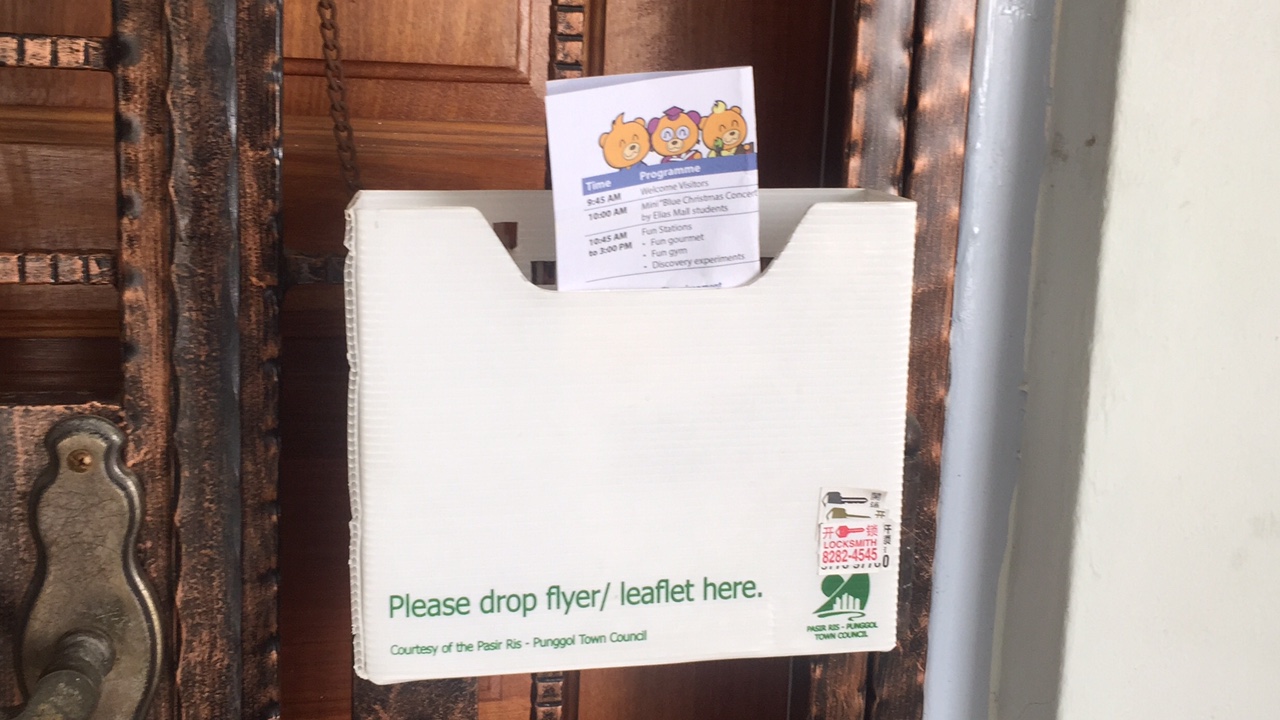SINGAPORE: While some residents might complain about their mailbox being clogged up with promotional offers, furniture catalogues and discounts from food establishments, such advertising material is welcomed by most residents, SingPost has told Channel NewsAsia.
That could explain why only 0.8 per cent of the 1.2 million Singapore households have chosen to opt of receiving unaddressed advertisements.
The service – introduced in 2006 – was provided for residents who prefer not to receive advertising mail. Residents can either call SingPost or apply through its website and an orange “No Admail” sticker will be attached to the back of the letterbox.
“From our data, most of the residents in Singapore welcome the catalogues and discount coupons they receive in their mailboxes,” said a SingPost spokesperson last week.
“We also understand that there are residents who may prefer not to receive these free mailers so, to respect their wishes, we provide them an opt-out option,” the spokesperson added.

Residents who have opted out of receiving admail from SingPost will have an orange “No Admail” sticker attached to the back of the letterbox. (Photo: SingPost)
RISING DEMAND FOR DOOR-TO-DOOR DISTRIBUTION
But while most residents still take delivery of advertising material from SingPost, the increasing use of mailboxes with anti-junk mail features is presenting problems for flyer distribution companies. This has forced them to adopt a different delivery strategy as more households block their mailboxes.
Alibaba Printing’s sales and marketing manager Chris Tan said that more companies which want to distribute advertising material are choosing door-to-door over letterbox distribution, although the former option is more expensive. Since 2009, his company has seen a 10 per cent increase in door-to-door deliveries.
“Our clients feel that they can reach their customers more effectively through door-to-door distribution. It’ll be faster to get to customers, especially for businesses that have new launches,” said Mr Tan. “For example, there is a new restaurant and they need to target the residents within a certain time frame. They will look for us to distribute flyers rather than using a digital platform.”
Citypost Asia’s executive director Victor Ho estimated that a small minority of letterboxes are now accessible to companies like his, forcing him to switch focus to door-to-door distribution in 2009.
“Only 15 per cent of the letterboxes are accessible. How do you distribute?” said Mr Ho. “Door-to-door is more effective because the households can receive it and they can have a look at the flyers, instead of putting it at the letterbox (where) they will just take them and throw away without looking at it,” he added.
But some residents that Channel NewsAsia spoke to said they find these flyers to be a turn-off as more of such material is stuck into front gates or pushed under doors.
“I think it’s fine to receive the mail in my letterbox. But for the mail that is at the door, I do find it quite annoying. Because when there are too many flyers, it messes up the outlook of the house,” said Pasir Ris resident Nur Fitriah, 27.
32-year-old Mohamed Faiz agreed, saying that such material is a waste of resources. “It doesn’t serve much purpose. I feel it’s more junk mail when it’s at my door rather than useful information. Because (for) most of the things we can get it from internet, not flyers. Flyers are just a waste of resources; we just throw them away,” he said.
Recognising that some resident don’t like flyers being stuffed randomly, distributor Lim Yuan Hua said that he makes an effort to place the marketing material in the gate hinges and not dirty the surroundings. “I’ll fold the flyers and I will slot them in the gap of the metal gate. For letterboxes, I’ll just use my bare hands to do from left to right so as to avoid any scratches on the letterboxes,” said the 28-year-old.
“Sometimes residents will complain and say ‘Hey, why are you putting junk mail at my doorstep?’ So what I will do is I’ll go back to the unit and take back the flyer and just walk away.”
TOWN COUNCILS PROVIDE BOXES FOR RESIDENTS TO COLLECT FLIERS
To help residents manage the problem, Pasir Ris-Punggol Town Council started a pilot project in 2011 by distributing a few hundred containers to its residents.
Residents can choose to attach the container to their gate to collect flyers. The town council’s spokesperson Regina Ang said they started the initiative after receiving feedback from residents about flyers stuck in their gates or strewn along the common corridors.
“We noticed that some residents solved the problem by hanging a plastic container or basket at their gate to collect these flyers. We also noticed that with such receptacles, the common corridors looked neater without flyers strewn on the floor or having them stuck at the gate,” said Ms Ang, adding that the town council has since distributed a flyer box to all households in the constituency.

Pasir Ris-Punggol Town Council provides a box for each household in its constituency to collect flyers. (Photo: Lim Jia Qi)
The response was so well-received that Nee Soon GRC started a similar initiative in 2014 for its 57,000 households.
Said the town council’s spokesperson Pauline Kwa: “The rationale is to minimise unsightly flyers being stuffed between the gates, under the doors or strewn along corridors. This also reduces the risk of residents slipping on these flyers, and lightens the workload of our cleaners. It is also more convenient for residents in clearing the items in the boxes.”
But for some residents like Mr Ng, he hopes that the authorities can do something to address the problem.
“The flyers are a nuisance. The authorities should do something about it. Currently, there is a Personal Data Protection Act to prevent consumers from receiving any telemarketing messages. This should include flyer distribution,” said the Choa Chu Kang resident.




